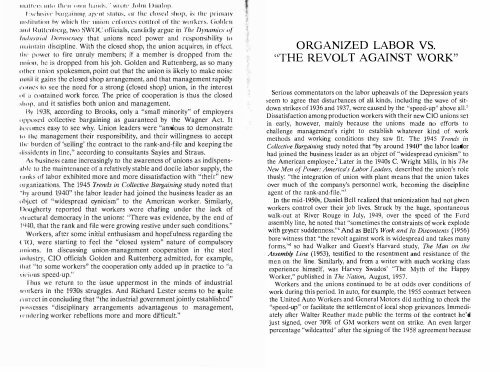CONTENTS - ouroboros ponderosa
CONTENTS - ouroboros ponderosa
CONTENTS - ouroboros ponderosa
You also want an ePaper? Increase the reach of your titles
YUMPU automatically turns print PDFs into web optimized ePapers that Google loves.
III;I/ln; Ililt l 1 iiI" II 11\\111 1i,llId; , " wlull' .Iuhll I )lllIlllp_<br />
I ,' ..;dll:-.ivt" h:lIg;lilllll1', ;11',1"111 slalus. or the closed shop, is Iht' primarv<br />
IlislituliPIi hv wllich Illl' lI11itllJ t'nforces control of the wllrf...crs, (;oldclI<br />
:",,1 I{ultt'llherg, two SWOC officials, cantlitlly argue in 'IIII' f)ynllmic.\· or<br />
/1II/lIs'ri,,/ f)enwcmcy that unions neetl power anti responsibility to<br />
"",illiain discipline. With the closed shop, the union acquires, in effect,<br />
III(' power to fire unruly members; if a member is dropped from the<br />
IIIIjoll, he is dropped from his job. Golden and Ruttenberg, as so many<br />
other union spokesmen, point out that the union is likely to make noise<br />
""lil it gains the closed shop arrangement, and that management rapidly<br />
COllie'S to see the need for a strong (closed shop) union, in the interest<br />
"I' a contained work force. The price of cooperation is thus the closed<br />
shop, and it satisfies both union and management.<br />
By I 93R, according to Brooks, only a "small minority" of employers<br />
"pposed collective bargaining as guaranteed by the Wagner Act. It<br />
t",mmes ea.;,y to sec why. Union leaders were "anxious to demonstrate<br />
10 I he management their responsibility, and their willingness to accept<br />
III(' burdcn of 'selling' the contract to the rank·and-file and keeping the<br />
di"jdcnts in line," according to consultants Sayles and Straus.<br />
As business carne increasingly to the awareness of unions as indispens'<br />
ahk 10 the maintenance of a relatively stable and docile labor supply, the<br />
rallks of labor exhibited more and more dissatisfaction with "their" new<br />
organizations. The 1945 Trends in Collective Bargaining study noted that<br />
"hy around 1940" the labor leader had joined the business leader as an<br />
Ilh.ict of "widespread cynicism" to the American worker. Similarly,<br />
Dougherty reported that workers were chafing under the lack of<br />
st ructural democracy in the unions: "There was evidence, by the end of<br />
I ')40, that the rank and file were growing restive under such conditions."<br />
Workers, after some initial enthusiasm and hopefulness regarding the<br />
(·to, were starting to feel the "closed system" nature of compulsory<br />
,,"ions. In discussing union-management cooperation in the steel<br />
i"dustry, CIa officials Golden and Ruttenberg admitted, for example,<br />
Ihat "to some workers" the cooperation only added up in practice to "a<br />
vi{'julls speed-up,"<br />
Thus we return to the issue uppermost in the minds of industrial<br />
","rkers in the 1930s struggles. And Richard Lester seems to be quite<br />
WHect in concluding that "the industrial government jointly established"<br />
I'"ssesses "disciplinary arrangements advantageous to management,<br />
II' ,"kring worker rebellions more and more difficult."<br />
--'<br />
"<br />
•<br />
. J<br />
•<br />
><br />
.'<br />
,<br />
'. '<br />
'.<br />
ORGANIZED LABOR VS.<br />
"THE REVOLT AGAINST WORK"<br />
Serious commentators on the labor upheavals of the Depression years<br />
seem to agree that disturbances of all kinds, including the wave of sitdown<br />
strikes of 1936 and 1937, wcre caused by the "speed-up" above all.'<br />
Dissatisfaction among production workers with their new CIa unions set<br />
in early, however, mainly because the unions made no efforts to<br />
challenge management's right to cstablish whatever kind of work<br />
methods and working conditions they saw fit. The 1945 Trends in<br />
Collective Bargaining study noted that "by around 1940" Ihe labor leader<br />
had joined the business leader as an object of "widespread cynicism" to<br />
the American employee .' Later in the 1940s C. Wright Mills, in his 'J)"<br />
New Men of Power: America's Labor l"eaders, described the union's role<br />
thusly: "the integration of union with plant means that the union takes<br />
over much of the company's personnel work, becoming the discipline<br />
agent of thc rank-and-fiIe.";<br />
.<br />
In the mid-1950s, Daniel Bell realized that unionization had not gIVen<br />
workers control over their job lives. Struck by the huge, spontaneous<br />
walk-out at River Rouge in July, 1949, over the speed of the Ford<br />
assembly line, he noted that "sometimes the constraints of work explode<br />
with geyser SUddenness.'" And as Bell's Work and Its Discontents (1956)<br />
bore witness that "the revolt against work is widespread and takes many<br />
forms,'" so had Walker and Guest's Harvard study, Th e Man on the<br />
Assembly Line (1953), testified to the resentment and resistance of the<br />
men on the line. Similarly, and from a writer with much working class<br />
experience himself, was Harvey Swados' "The Myth of the Happy<br />
Worker," published in The Nation, August, 1957.<br />
Workers and the unions continued to be at odds over conditions of<br />
work during this period. In auto, for example, the 1955 contract between<br />
the United Auto Workers and General Motors did nothing to check the<br />
"speed-up " or facilitate the settlement of local shop grievances. Immedi·<br />
ately after Walter Reuther made public the terms of the contract he'd<br />
just signed, over 70% of GM workers went on strike. An even larger<br />
percentage "wildcatted" after the signing of the 1958 agreement because






